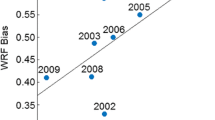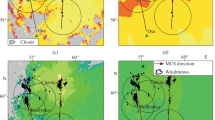Abstract
Many observational studies have shown that deformation, like vertical vorticity and divergence, is closely related to the occurrence and distribution of strong precipitation. In this paper, to involve deformation in precipitation diagnosis, a new parameter called potential deformation (PD) is derived and then applied to precipitation detection within a simulated mesoscale convective system (MCS). It is shown that PD includes both stretching deformation and shearing deformation and shares similar characteristics with deformation insofar as it does not change with the rotating coordinate. Diagnosis of the simulated MCS reveals that PD performs well in tracing the MCS’ precipitation. In terms of their distributional pattern, the large-value areas of PD are similar to the precipitation in the different development stages of the MCS. A detailed analysis of the physical processes contained within the PD shows that it can reflect the three-dimensional moisture variation, vertical wind shear and wind deformation within the MCS. These structures are usually a comprehensive reflection of the characteristics of the surface cold pool, rear inflow jet, downward cold air flow and upward warm moist flow within the precipitating convective cells. For this reason, the PD shows much stronger anomalies in the precipitating atmosphere than the non-precipitating atmosphere, which implies considerable potential for its application in detecting heavy precipitation within MCSs.
摘要
许多研究表明, 变形和涡度, 散度一样与强降水的发生发展及分布密切相关. 为了将变形引入到降水的诊断中, 本文提出了一个新的参数—位势形变. 位势形变包含位势伸缩形变和位势切变形变, 且可证明其和形变一样不随坐标的旋转而改变. 将位势形变应用到一次MCS降水过程的诊断分析发现, 位势形变对MCS降水有良好指示意义, 在MCS降水发展的不同阶段, 位势形变的大值区均随着降水的移动而移动. 对包含在位势形变中的物理过程的分析发现位势形变包含三维水汽梯度, 垂直风切变和变形, 这些物理信息能够综合反映MCS中降水单体内的冷池, 尾部入流, 下沉冷气流与上升暖气流的对峙等结构. 因此, 位势形变能够显著区分降水大气与非降水大气, 这体现了位势形变在MCS降水追踪方面的潜力.
Similar content being viewed by others
References
Barnes, S. L., 1964: A technique for maximizing details in numerical weather map analysis. J. Appl. Meteor., 3, 396–409.
Barnes, S. L., 1973: Mesoscale objective map analysis using weighted time-series observations. NOAA Tech. Memo. ERL NSSL-62, 60 pp. [NTIS COM-73-10781].
Bluestein, H. B., 1977: Synoptic-scale deformation and tropical cloud bands. J. Atmos. Sci., 34, 891–900.
Bluestein, H. B., 1992: Kinematics of the wind field. Synopticdynamic meteorology in midlatitudes Oxford University Press, New York, 81–109.
Cho, H. R., Z. H. Cao, 1998: Generation of moist potential vorticity in extratropical cyclones. Part II: Sensitivity to moisture distribution. J. Atmos. Sci., 55, 595–610.
Deng, Q. H., 1986: The deformation field in the planetary boundary layer and heavy rainfall. Journal of Academy of Meteorological Science, 1(2), 165–174 (in Chinese).
Doswell, C. A., H. E. Brooks, and R. A. Maddox, 1996: Flash flood forecasting: An ingredients-based methodology. Wea. Forecasting, 11, 560–581.
Eliassen, A., 1962: On the vertical circulation in frontal zones. Geofys. Publ., 24(4), 147–160.
Ertel, H., 1942: Ein neuer hydrodynamischer Wirbelsatz. Meteorology Zeitschr Braunchweigs, 59, 277–281.
Fritsch, J. M., and R. E. Carbone, 2004: Improving quantitative precipitation forecasts in the warm season: A USWRP research and development strategy. Bull. Amer. Meteor. Soc., 85, 955–965.
Fritsch, J. M., R. J. Kane, and C. R. Chelius, 1986: The contribution of mesoscale convective weather systems to the warmseason precipitation in the United States. J. Climate Appl. Meteor., 25, 1333–1345.
Gao, S. T., F. Ping, X. F. Li, and W. K. Tao, 2004a: A convective vorticity vector associated with tropical convection: A two-dimensional cloud-resolving modeling study. J. Geophys. Res., 109(D14), D14106.
Gao, S. T., X. R. Wang, and Y. S. Zhou, 2004b: Generation of generalized moist potential vorticity in a frictionless and moist adiabatic flow. Geophys. Res. Lett., 31, L12113.
Gao, S. T., S. Yang, M. Xue, and C. G. Cui, 2008: Total deformation and its role in heavy precipitation events associated with deformation-dominant flow patterns. Adv. Atmos. Sci., 25(1), 11–28, doi: 10.1007/s00376-008-0011-y.
Gao, S. T., X. F. Li, W. K. Tao, C. L. Shie, and S. Lang, 2007: Convective and moist vorticity vectors associated with tropical oceanic convection: A three-dimensional cloud-resolving model simulation. J. Geophys. Res., 112(D1), D01105.
Hoskins, B. J., M. E. McIntyre, and A. W. Robertson, 1985: On the use and significance of isentropic potential vorticity maps. Quart. J. Roy. Meteor. Soc., 111, 877–946.
Karyampudi, V. M., and T. N. Carlson, 1988: Analysis and numerical simulations of the Saharan air layer and its effect on easterly wave disturbances. J. Atmos. Sci., 45(21), 3102–3136.
Keyser, D., M. J. Reeder, and R. J. Reed, 1988: A generalization of Petterssen’s frontogenesis function and its relation to the forcing of vertical motion. Mon. Wea. Rev., 116, 762–781.
Koch, S. E., 1984: The role of an apparent mesoscale frontogenetic circulation in squall line initiation. Mon. Wea. Rev., 112, 2090–2111.
Koch, S. E., and J. McCarthy, 1982: The evolution of an Oklahoma dryline. Part II: Boundary-layer forcing of mesoconvective systems. J. Atmos. Sci., 39, 237–257.
Li, N., L. K. Ran, and S. T. Gao, 2016: The impact of deformation on vortex development in a baroclinic moist atmosphere. Adv. Atmos. Sci., 33, 233–246, doi: 10.1007/s00376-015-5082-y.
Lin, Y. L., R. D. Farley, H. D. Orville, 1983: Bulk parameterization of the snow field in a cloud model. J. Appl. Meteorol., 22, 1065–1092.
Maddox, R. A., 1980: An objective technique for separating macroscale and mesoscale features in meteorological data. Mon. Wea. Rev., 108, 1108–1121.
Market, P. S., and D. Cissell, 2002: Formation of a sharp snow gradient in a midwestern heavy snow event. Wea. Forecasting, 17, 723–738.
Mason, B. J., 1971: The Physics of Clouds. 2nd ed., Oxford University Press, 671 pp.
Markowski, P., and Y. Richardson, 2010: Mesoscale Meteorology in Midlatitudes. Wiley-Blackwell, 407pp.
Mofor, L. A., and C. G. Lu, 2009: Generalized moist potential vorticity and its application in the analysis of atmospheric flows. Progress in Natural Science, 19, 285–289.
Orlanski, I., 1975: Rational subdivision of scales for atmospheric processes. Bull. Amer. Meteor. Soc., 56, 527–530.
Ran, L. K., and N. Li, 2014: PV-based wave-activity density and its application to tracing heavy precipitation. Meteor. Atmos. Phys., 123, 33–50.
Sawyer, J. S., 1956: The vertical circulation at meteorological fronts and its relation to frontogenesis. Proceedings of the Royal Society A: Mathematical, Physical and Engineering Sciences, 234, 346–362.
Schultz, D. M., and J. A. Knox, 2007: Banded convection caused by frontogenesis in a conditionally, symmetrically, and inertially unstable environment. Mon. Wea. Rev., 135, 2095–2110.
Schumacher, R. S., and R. H. Johnson, 2005: Organization and environmental properties of extreme-rain-producing mesoscale convective systems. Mon. Wea. Rev., 133, 961–976.
Steigerwaldt, H., 1986: Deformation zones and heavy precipitation. National Weather Digest, 11, 15–20.
Uccellini, L. W., and S. E. Koch, 1987: The synoptic setting and possible energy sources for mesoscale wave disturbances. Mon. Wea. Rev., 115, 721–729.
Weldon, R. B., 1979: Cloud patterns and the upper air wind field. AWS/TR-79/003, Air Weather Service, Scott AFB, 80 pp.
Xue, M., K. K. Droegemeier, V. Wong, A. Shapiro, and K. Brewster, 1995: ARPS version 4.0 user’s guide. Center for Analysis and Prediction of Storms, University of Oklahoma, 380 pp. [Available online at http://www.caps.ou.edu/ARPS/arpsdoc. html.]
Xue, M., K. K. Droegemeier, and V. Wong, 2000: The Advanced Regional Prediction System (ARPS)—A multiscale nonhydrostatic atmospheric simulation and prediction tool. Part I: Model dynamics and verification. Meteor. Atmos. Phys., 75, 161–193.
Xue, M., and Coauthors, 2001: The Advanced Regional Prediction System (ARPS)—A multi-scale nonhydrostatic atmospheric simulation and prediction tool. Part II: Model physics and applications. Meteor. Atmos. Phys., 76, 143–165.
Xue, M., D. H. Wang, J. D. Gao, K. Brewster, and K. K. Droegemeier, 2003: The Advanced Regional Prediction System (ARPS), storm-scale numerical weather prediction and data assimilation. Meteor. Atmos. Phys., 82, 139–170.
Yue, C. J., Y. X. Shou, S. W. Shou, G. Zeng, and Y. Q. Wang, 2007: Wet Q vector interpretation technique with its application to quantitative precipitation forecast. Journal of Applied Meteorological Science, 18(5), 666–675 (in Chinese).
Ziegler, C. L., W. J. Martin, R. A. Pielke, and R. L. Walko, 1995: A modeling study of the dryline. J. Atmos. Sci., 52, 263–285.
Acknowledgements
This study was supported by the Special Scientific Research Fund of the Meteorological Public Welfare of the Ministry of Sciences and Technology (Grant No. GYHY201406002, GYHY201406001), National Key Technology Support Program (Grant No. 2015BAC03B04), a National Program on Key Basic Research project (Grant No. 2013CB430105), the Major Research Plan of the National Natural Science Foundation of China (Grant No. 91437215), the National Natural Science Foundation of China (Grant Nos. 41505040, 41375052 41405055 and 41575065), the Open Project of the State Key Laboratory of Severe Weather (LaSW), the Chinese Academy of Meteorological Sciences (CAMS) (Grant No. 2015LASW-B05), and the Beijing Natural Sciences Foundation (Grant No. 8142035).
Author information
Authors and Affiliations
Corresponding author
Rights and permissions
About this article
Cite this article
Li, N., Ran, L., Zhang, L. et al. Potential deformation and its application to the diagnosis of heavy precipitation in mesoscale convective systems. Adv. Atmos. Sci. 34, 894–908 (2017). https://doi.org/10.1007/s00376-017-6282-4
Received:
Revised:
Accepted:
Published:
Issue Date:
DOI: https://doi.org/10.1007/s00376-017-6282-4




